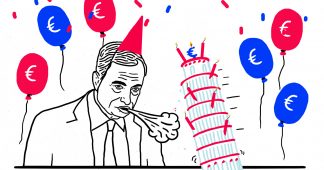When European Central Bank chief Mario Draghi left office last month, he was widely praised for “saving the euro.” But he did this at the expense of working people — exploiting the crisis to impose an ever more unbreakable austerity regime.
By Thomas Fazi
Nov. 17, 2019
Through the mechanisms pioneered by Draghi and his “activist” approach to central banking, formal democratic processes have been systematically subverted through financial and monetary blackmail — first and foremost at the hands of the ECB. Under such governance structures, one may reasonably question whether eurozone member states can still be considered democracies, even according to the narrow “bourgeois” understanding of the concept. Ultimately, Draghi symbolizes the dangerous rise to power of the unelected technocrats — “experts” who claim to be untainted by politics, but who in fact embody capital’s desire for unfettered domination.
Birth of a Monster
Draghi didn’t come from nowhere. He assumed his position as the new president of the ECB in late 2011, following a distinguished career as managing director of Goldman Sachs (2002–2005) and governor of the Bank of Italy (2005–2011). Already by this point, Europe’s central bank had attracted much criticism, even from mainstream circles, for its handling of the financial crisis and subsequent recession. In 2010 and 2011, the ECB opposed all talk of restructuring Greece’s debt, instead saddling its government with additional debt that went to pay off its French and German bank creditors.
In 2011, when every other central bank was lowering interest rates, the ECB instead raised interest rates twice, further exacerbating the recession. Most troublingly, in the early years of the crisis, Draghi’s predecessor Jean-Claude Trichet refused seriously to intervene to support euro-area government bond markets, leaving member states at the mercy of financial speculation and forcing them to pursue harsh austerity measures to meet growing interest payments. In some cases, this forced states to go cap-in-hand to the so-called troika — a tripartite committee with representatives of the European Commission, the ECB, and the International Monetary Fund (IMF) — for financial assistance. This was itself a political tool, with the “help” accorded conditional upon even harsher austerity measures.
As Trichet would later admit, the central bank’s refusal to support public bond markets in the first phase of the financial crisis was aimed at pressuring eurozone governments into consolidating their budgets and implementing (neoliberal) “structural reforms.”
With Draghi’s arrival, many hoped this would change. The hope was that the ECB would finally take a more interventionist and muscular approach to the so-called European sovereign debt crisis, which by then was in full swing. And intervention is exactly what they got — though not of the kind most had in mind. It was a classic case of “be careful what you wish for.” For Draghi radicalized the kind of interference in member states’ affairs which had emerged already under Trichet.
Indeed, this was visible already in August 2011, a few months before Draghi officially took up his position at the ECB. Amid rising interest rates on Italian bonds, Draghi and Trichet sent an extraordinary letter to the Italian government which was intended to remain secret. But it was subsequently leaked — and showed exactly how the ECB intended to make use of the crisis to blackmail Italy into mounting “structural reforms.”
The letter claimed that Italy’s postcrisis deficit-cutting plan was “not sufficient” and demanded “a major overhaul of the public administration” — including “the full liberalisation of local public services”; “large scale privatizations”; “reducing the cost of public employees . . . if necessary, by reducing wages”; “reform [of] the collective wage bargaining system”; “more stringent . . . criteria for seniority pensions”; and even “constitutional reform tightening fiscal rules.” All this, it was claimed, was needed in order “to restore the confidence of investors.”
Such demands represented a huge overstepping of the ECB’s monetary prerogatives. Giulio Tremonti, Italy’s then economy and finance minister, later said that his government received two threatening letters that summer: one from a terrorist group, the other from the ECB. “The one from the ECB was worse,” he quipped. The Italian government responded by pledging far-reaching reforms and deeper budget cuts, at which the ECB agreed to intervene to buy Italian bonds to keep borrowing costs down.
By September, however, Italian ten-year bond yields had started rising once again, and by November they reached the critical threshold of 7 percent, forcing Prime Minister Silvio Berlusconi to resign following the loss of his parliamentary majority. At that point, Italian president Giorgio Napolitano appointed Mario Monti, a former European commissioner and international adviser to Goldman Sachs, to form a so-called technical government — one supposedly standing above political divides.
Most accounts portrayed this political crisis as the financial markets’ “natural” response to Berlusconi’s poor handling of the economic crisis, in line with the dominant narrative of the European “debt crisis.” The reality, however, is far more troubling. As even the Financial Times recently acknowledged, it is by now increasingly clear that the ECB under Draghi “forced Silvio Berlusconi to leave office in favor of unelected Mario Monti,” by discontinuing its Italian bond purchases — thus deliberately causing interest rates to rise above safety levels — and by making Berlusconi’s ouster the precondition for further support by the ECB for Italian bonds and banks. This was belatedly admitted even by Mario Monti himself, who claimed in a 2017 interview that in late 2011 Draghi had “decided to stop the purchases of Italian government bonds, which had kept the Berlusconi government afloat in the summer and autumn of 2011.”
No More “Social Europe”
It is hard to imagine a more disturbing scenario than a supposedly “independent” and “apolitical” central bank resorting to monetary blackmail in order to oust an elected government from office and impose its own political agenda. Yet by all evidence this is what happened in Italy in 2011. As Jacob Kirkegaard of the Peterson Institute for International Economics noted that same year, under Draghi’s leadership the ECB was rapidly evolving into a “full-blooded political actor engaging in a strategy aimed at forcing EU political leaders to embrace fiscal rectitude.”
This became even more evident when, just a month after his silent coup in Italy, Draghi, launched the idea of a “fiscal compact” — what he termed “a fundamental restatement of the rules to which national budgetary policies ought to be subject so as to gain credibility beyond doubt.” This resulted, in March 2012, in the signing by all EU member states (with the notable exceptions of the United Kingdom and the Czech Republic) of an even stricter version of the Stability and Growth Pact (SPG) established by the Maastricht Treaty: the so-called Treaty on Stability, Coordination and Governance in the Economic and Monetary Union, commonly known as the Fiscal Compact.
The new treaty had direct political effects, and ones designed to last. In particular, it required member states to transpose a “balanced budget rule” into national legal systems “through binding and permanent provisions, [and] preferably constitutional [ones].” This amounted to nothing less than an attempt to institutionalize and crystallize on a European scale the supposedly “emergency” austerity programs that were pursued by the EU elite and imposed on member states since the beginning of the euro crisis. A joint statement issued at the time by the Corporate Europe Observatory and the Transnational Institute noted that the Fiscal Compact would institute “a permanent [austerity] regime that will inevitably lead to cuts so deep that it can make the European welfare state history.”
Indirectly confirming such fears, in an interview given shortly thereafter to the Wall Street Journal, Draghi made clear there was no debate: “There was no alternative to fiscal consolidation,” he said. “The European social model has already gone.” The treaty also introduced, for the first time, “automatic correction mechanisms” and quasi-automatic sanctions in the event of noncompliance with the rules, to remove any element of discussion and democratic deliberation, thus accomplishing a lifelong neoliberal dream: the complete separation between the democratic process and economic policies, and the death of active macroeconomic management.
Simply put, the Fiscal Compact aimed at putting the economy on autopilot, effectively insulating it from popular challenge. The concept was further elucidated by Draghi in 2013. Following an indecisive Italian election in which the “populist” Five Star Movement emerged as the country’s number one party, Draghi allayed fears that this might cause Italy to stray from the path of austerity and thus reignite Europe’s debt crisis. He insisted that “much of the fiscal adjustment Italy went through will continue on automatic pilot.” The message was clear: thanks to the new postcrisis governance regime he had pioneered, election results would no longer really matter. The reengineering of European societies and economies, subjected to an even more radical neoliberal framework, would continue regardless of the democratic will of the European peoples. As Germany’s finance minister put it, even more explicitly: “Elections change nothing. There are rules.”
Saving the Euro
But this depoliticization and de-democratization of economic policy was also what allowed Draghi his greatest triumph — his famous speech that “saved the euro” in summer 2012. Here, Draghi announced the ECB’s Outright Monetary Transactions (OMT) program, under which it pledged, if necessary, to engage in unlimited purchases of government bonds on secondary bond markets in order to preserve “an appropriate monetary policy transmission and the singleness of the monetary policy” — or more simply, as Draghi put it, “to do whatever it takes to preserve the euro.”
The implication was that if markets demanded excessively high interest rates, the ECB would step in and buy the bonds itself, theoretically putting an end to the speculators’ game. Draghi’s announcement succeeded in immediately bringing down interest rates in affected countries (without even having to actually activate a single OMT program), indirectly confirming that bond yields are ultimately determined by the central bank’s monetary policy, not by “market confidence” in a country’s policies or deficit- and debt-to-GDP levels, contrary to what Draghi had repeatedly claimed until then (and would continue repeating in the following years).
However, while this helped countries avert insolvency, it did little to help them in terms of boosting their economies, which would have required stimulatory fiscal policies (that is, higher deficits) — precisely what the new fiscal framework championed by Draghi prohibited. In this sense, OMT fell far short of transforming the ECB into a “normal” central bank: in fact, accessing OMT support entails “strict and effective conditionality” — that is, austerity and neoliberal “structural reforms” — on behalf of the applying country. No wonder why no country has yet applied for an OMT program.
In other words, whereby other central banks (such as the Federal Reserve in the United States) engaged in expansionary (bond-buying) monetary policies precisely to support governments carry out a fiscal expansion, the ECB did the exact opposite: it agreed to intervene on bond markets only on condition that governments would not increase their deficits and would engage in austerity instead. As Marshall Auerback notes, “[i]in effect, the right hand stole from the left hand, as the austerity measures simply exacerbated the problem of poor consumer and business demand and forced the governments concerned to issue yet more national debt.” This is also the reason why the ECB’s quantitative easing (QE) program, belatedly launched in 2015, has colossally failed to raise inflation in the euro area, leaving many economies trapped in a “lowflationary” spiral that causes production, employment, and wages to stagnate.
Crushing Greece
In short, the various institutional innovations introduced by Mario Draghi over the years, which have earned him much praise, have not transformed the ECB into a lender of last resort, on which national governments can rely, but instead have made it a “dealer of last resort,” with the power to exploit countries’ economic difficulties of countries to blackmail them into implementing neoliberal and austerity-driven reforms.
This became clear in the summer of 2015, when Draghi demonstrated just how far he was willing to go to uphold the eurozone’s fiscal-economic status quo, even if it meant bringing an entire country to its knees. After the left-wing party Syriza, led by Alexis Tsipras, which had campaigned on a radical anti-austerity platform, came to power in Greece in January 2015, a dramatic political standoff ensued between the Greek government and the EU authorities. Tsipras attempted to renegotiate the country’s public debt, fiscal policy and reform agenda, and reverse the austerity policies that had so damaged the country. Yet the standoff was already over by summer, when Greece’s government capitulated and accepted the onerous terms of yet another loan agreement conditional on further austerity and deregulation measures — effectively putting an end to the Greek “rebellion.”
Syriza’s capitulation is generally blamed on the leading European states (first and foremost Germany). However, the most pernicious role was played by the ECB itself. Indeed, in Europe’s war against the new Greek government, the first shots were fired by the central bank. On February 4, just nine days after Syriza’s first election victory, the ECB deprived the Greek government of one of its main lines of credit, ruling that it would no longer allow Greek banks to access “normal” ECB liquidity by offering as collateral Greek government bonds that were officially rated “junk” — an exception granted to those countries undergoing a troika financial aid program. From that moment on, the banks would have to rely on the more expensive Emergency Liquidity Assistance (ELA). The ECB offered the excuse that it was “currently not possible to assume a successful conclusion of the [financial aid] programme review.”
This was an extraordinary decision, for a number of reasons: the new Greek government was only one week old, and had three more weeks to extend the loan agreement with the creditors and the troika. Worse, the ECB’s move set in motion a bank run that dramatically accelerated the capital flight that had already set underway. Months of very tense negotiations followed, during which the Greek government’s proposals were all dismissed by the troika, further exacerbating the outflow of capital and causing the asset value and market capitalization of Greek banks to plummet. The situation came to a head in June 2015. On June 25, the Tsipras government rejected the “final offer” put forward by the troika for a new loan to allow the government to roll over a payment of €1.55 billion owed to the IMF, and two days later, in a strategic move to strengthen its hand in future negotiations, it announced that it would be holding a referendum on the terms of the offer, to be held on July 5. The following day, on June 28, the ECB refused Greece’s central bank the right to increase its ELA facility, leaving the Greek government no choice but to shut down the nation’s banks, impose capital controls, and restrict individual withdrawals to €60 per day, at an enormous cost to Greek business and citizens.
The rest of the story is well known: although the Greek people rejected en masse the austerity package demanded by the troika, the Greek government did a political volte face and accepted the European Union’s terms, which were even more punitive than those that it had previously rejected. There’s no doubt that the ECB played a crucial role in ultimately bringing the Greek government to heel, in what clearly amounted to a strictly political move without purely technical justification. As economist Mario Seccareccia writes, the ECB cut off liquidity to the Greek banks “even though it knew fully well that this was not primarily because of a solvency problem for Greek banks but overwhelmingly it was a systemic liquidity problem arising from the growing uncertainty and fears on the part of the public reflected in the progressive hoarding of liquid funds” — fears that were “undoubtedly compounded by the actions of the ECB itself”:
Hence, instead of seeking to support and promote the smooth operation of the payments system of one of its member states that, at no time, had officially proposed exit from the Eurozone (in fact, it was the German leaders who were strategizing a “temporary” Grexit), the ECB actually cut off its liquidity assistance deliberately in order to destabilize further the Greek payments system and force the Syriza government into accepting the harsh austerity measures.
This episode proves that in the eurozone the supposed benefits of central bank independence have instead been replaced by government dependence on central banks, no longer subject to any kind of democratic control. One would be hard-pressed to find another instance in history in which a central bank deliberately crashed its own country’s banking system in order to force its political agenda upon the elected government. Yet this is exactly what happened under Draghi.
This experience also shows that the euro area’s problems extend far beyond the differences among countries, or the fact that it lacks federal-level stabilization mechanisms and truly representative institutions (though all these things are true). The reality is much more disquieting: over the course of the past decade, the eurozone has evolved from post-democratic managerialism to an authoritarian iron cage. And, to a large degree, we have Mario Draghi to thank for that
* Thomas Fazi is a writer, journalist, translator, and researcher. He is the co-author of “Reclaiming the State: A Progressive Vision of Sovereignty for a Post-Neoliberal World” (Pluto Press; 2017).
Published at https://jacobinmag.com/2019/11/mario-draghi-european-central-bank-euro-debt-crisis











